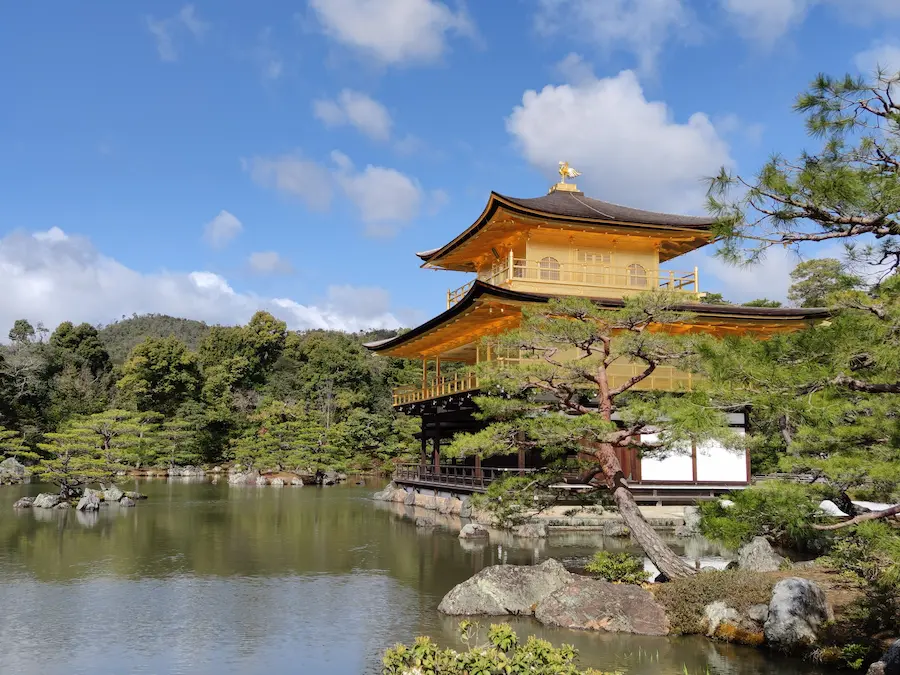History
Kinkaku-ji Temple, also known as the Golden Pavilion or Pagoda, is one of the most iconic and visited landmarks in Kyoto, famous for its stunning golden exterior and picturesque surroundings. (Kinkakuji Official WEB site)
Originally built in the late 14th century as a retirement villa for the 3rd shogun Ashikaga Yoshimitsu, Kinkakuji later transformed into a Zen Buddhist temple after his death. The temple’s name “Kinkaku” means “Golden Pavilion” in Japanese, referring to the lavish gold leaf covering the upper two floors of the structure.
Ashikaga Yoshimitsu took over the villa of Saionji Kokei, a court noble, and built this temple to represent the Pure Land of Ultimate Bliss. It was not until after Ashikaga Yoshimitsu’s death that it became a temple.

The official name of Kinkakuji Temple is Rokuonji Temple. Like Ginkakuji, it is one of the sub-temples (tacchu) of Shokokuji Temple.
Building and garden
The three-story structure of Kinkaku-ji represents different architectural styles. The first floor, called “Shinden-zukuri,” reflects the style of aristocratic residences from the Heian period. The second floor, “Buke-zukuri,” is reminiscent of samurai warrior houses, while the uppermost floor, “Karayo,” is in the traditional Zen temple style.
Unfortunately, the temple has faced several challenges throughout its history. It has been destroyed multiple times by fires and wars, with the most recent reconstruction dating back to 1955. Despite these setbacks, the current structure closely resembles the original, maintaining its historical and cultural significance.
The temple is situated within a beautifully landscaped garden that includes a large pond, various sculptures, and trees. The pond reflects the golden temple, creating a mesmerizing sight and a popular subject for photographers and artists. The garden itself is in a classical Japanese style, incorporating elements such as stones, bridges, and islands. They symbolize different aspects of nature and spirituality.
Kinkakuji Temple is a UNESCO World Heritage site and attracts numerous visitors from around the globe.
How to visit Kinkaku-ji
The nearest bus stop is the Kinkakuji-mae bus stop on Nishioji-dori. There are quite a few services from Kyoto Station and other major stations. Therefore, you don’t need to worry about the ride time, etc. so much.
The temple gate opens at 9:00 a.m., so we recommend getting there as early as possible. There are fewer visitors in the early morning and the temple building is beautiful in the morning sun.
Model courses for visiting Kinkakuji
Two world heritage sites, Ryoanji Temple and Ninnaji Temple are nearby. After visiting Kinkakuji early in the morning, you can easily walk to Ryoanji and Ninnaji in the morning.
Nearby spots from Kinkaku-ji Temple
Ryoanji Temple is a world heritage site and famous for its rock garden. It is one of the finest examples of Japanese Zen gardens.
Ninnaji Temple was originally established in 888. The temple complex covers a vast area and features numerous important cultural assets.
Related articles:
[…] Kinkakuji and Ginkakuji are sub-temples of Shokokuji. Although Shokokuji Temple is not so well known, please visit there as well. This visit was conducted during the spring special viewing. […]
[…] in the present-day Fujito-cho, Kurashiki City during the Genpei wars, brought to the present-day Kinkakuji Temple by Ashikaga Yoshimitsu, moved to Ginkakuji Temple during Ashikaga Yoshimasa’s reign, given to […]
[…] Kinkakuji Temple, go along Kinukake-no-michi a little toward Ryoanji Temple, and from there go south on […]
[…] is a 2.5 km long sightseeing road that goes from Kinkakuji Temple to Ninnaji Temple via Ryoanji Temple. It takes about 18 minutes on foot from Kinkakuji Temple to […]
[…] school of the Rinzai sect of Zen Buddhism. Although the temple has a long history and is close to Kinkakuji Temple and Ryoanji Temple, it is quiet and rarely visited by […]
[…] can visit Ninnaji Temple together with Kinkakuji Temple and Ryoanji Temple. All three temples are World Heritage […]
[…] Kinkakuji Temple and Ninnaji Temple are nearby. […]
[…] of Kyoto’s most famous attractions is the Golden Pavilion, also known as Kinkakuji, a three-story pavilion covered in gold leaf. Another notable attraction is the Fushimi Inari […]
[…] name “Ginkaku” (silver pavilion) was given to the temple during the Edo period. Since Rokuonji Temple was called “Kinkaku” (golden pavillion), Jishoji Temple, also a sub-temple of Shokokuji […]